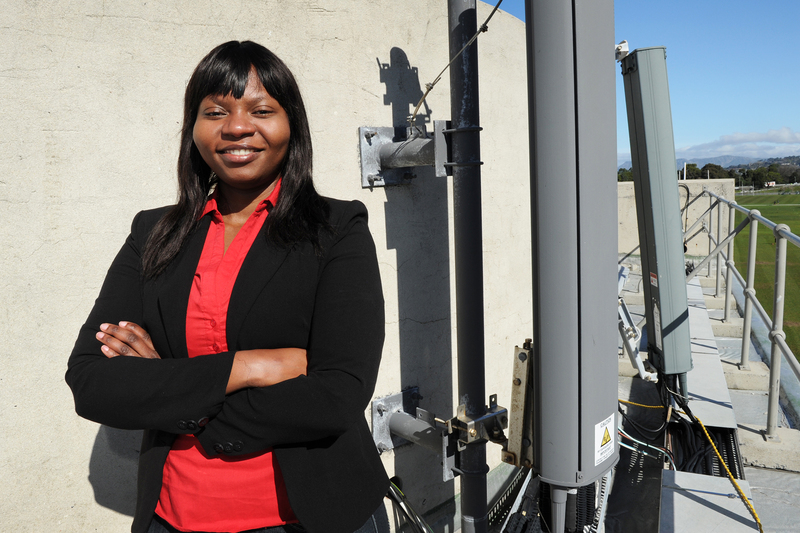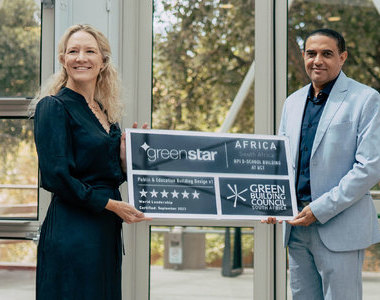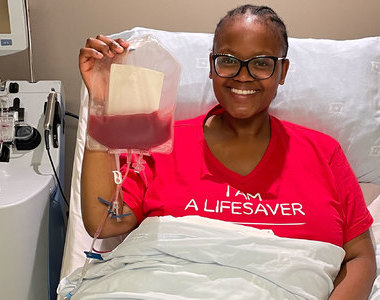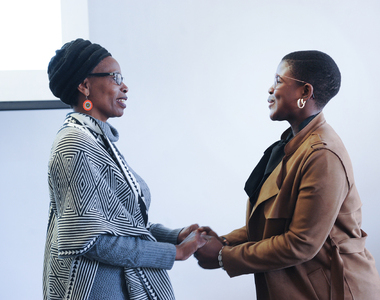Helping Africa prepare for 5G
09 September 2019 | Story Laura Rawden. Photo Michael Hammond. Read time 10 min.
As the fourth industrial revolution becomes part of our future, the University of Cape Town’s (UCT) Dr Joyce Mwangama is leading the way with the development of Africa’s first 5G testbed.
Most people are familiar with the connectivity that comes with 4G cellular network service: swift loading times while surfing, quick transfer of photos and videos, and cloud computing.
With the next generation of connectivity, things get even faster. 5G network service not only amplifies the speed of technology, but also creates the potential to use it to improve livelihoods.
A lecturer in the UCT Department of Electrical Engineering, she is leading the development of South Africa’s first university-based 5G testbed facility.
5G can be viewed as an enabler of the fourth industrial revolution, also known as the 4IR, which has been described by the World Economic Forum as a “fundamental change in the way we live, work and relate to one another”.
While the 4IR has great potential, it must be developed with consideration of the people it will help. In Africa, that means addressing issues of economic impact and social justice.
Driving research into 5G and its potential in Africa is Dr Joyce Mwangama. A lecturer in the UCT Department of Electrical Engineering, she is leading the development of South Africa’s first university-based 5G testbed facility: a live network for the development of advanced digital applications.
“From smart cities to mobile health, our facility enables us to test 5G services on a live network to help achieve 4IR goals in a structured and organised way,” says Mwangama.
Real network testing
Mwangama, who is a member of the UCT–Telkom Centre for Broadband Networks and Applications, received funding under the NRF Thuthuka Funding scheme to establish the UCT 5G testbed earlier this year.
The work involves the centre’s master’s and PhD researchers testing 5G applications on real hardware and software incarnations of the network. This is significant because most 5G research in South Africa is heavily theoretical.
“From smart cities to mobile health, our facility enables us to test 5G services on a live network to help achieve 4IR goals in a structured and organised way.”
“The testbed serves as a bridge where researchers can implement their ideas over a live network and work around issues that they might not have considered in a theoretical framework,” says Mwangama.
This not only strengthens research outputs but supports demonstration of prototypes that could drive 4IR products and services.
“If we can prototype these ideas, it gives appetite to the industry so that it’s aware of what’s possible and moves in that direction,” says Mwangama.
It also serves to push government and regulatory bodies to develop a framework around 5G network capabilities and access, which Mwangama says is important. “Cities in Africa have a good potential to leverage 5G use-cases – if they are planned and organised well.”
What is 5G?
5G applications include everything from driverless cars to robotics. Mwangama describes them more specifically as belonging to two classes: low-latency feedback services and the internet of things (IoT).
Low latency feedback refers to the amount of time it takes to send and receive information: the lower the latency, the faster the feedback. With current networks, sending and receiving information can take about 50 milliseconds. With 5G capabilities, it’s reduced to less than 10 milliseconds, and for some cases, less than one millisecond.
“This is beneficial for applications involving driverless cars or robots in a factory where you want instant reactions,” says Mwangama.
IoT refers to applications that help share information with the internet and other apps. Think about your smartphone using the internet to communicate with your fridge or your home security system.
“This involves machine-type communications and areas where you don’t want interventions from people,” says Mwangama.
“This means that the research is being carried out abroad. Then the products are put into our market without having been adapted for the African environment.”
This could be applied to things like transportation, such as through services that follow the environmental impact of traffic or vehicles. It could also be used in agriculture to improve crop output by giving farmers real-time information on irrigation, for example.
mHealth
5G technology could also be applied to strengthen the delivery of healthcare through mobile health (mHealth) services. This is an area where the most exciting work is happening at the UCT testbed, in collaboration with Dr Bessie Malila, a UCT postdoctoral research fellow in the UCT Department of Biomedical Engineering.
Among the mHealth projects the pair are working on is a mobile application that screens for latent tuberculosis (TB) infection. The app, which is currently in clinical trials, allows for remote reading of a standard, recommended TB test – the Mantoux test – and encourages better collection of results and follow-up care.
“The Mantoux test requires that patients return to the clinic to read the results, and in most cases, they don’t come back,” says Malila. “This is a waste of resources because the patient then needs to be tested again. And if they are infected, they end up going without treatment.”
With the app, patients can send an image of the results from their own phone. An algorithm then processes the image to send a report of the outcome to the clinic or doctor performing the test.
“If the test is negative, a text message is sent to the patient telling them the result. If it’s positive, the message advises them to seek treatment,” says Malila.
The 5G network is vital here for its low-latency communication and ability to collect real-time patient data.
“With no other known 5G testbed in Africa, the technology that Joyce is working with right now is the first of its kind.”
“It also gives us the ability to expand the use of other applications, such as augmented reality and virtual reality, to allow delivery of remote critical care services or remote training to doctors in real-time,” says Malila.
First of its kind
Currently, there are 5G testbeds in Europe, Japan and South Korea – where much of the research in the field is being done. “This means that the research is being carried out abroad. Then the products are put into our market without having been adapted for the African environment,” Malila says.
Having the testbed facility at UCT not only positions South Africa to drive 4IR on the continent, but also to support a new generation of researchers.
“The testbed provides a platform for researchers not only in South Africa but also other African countries to validate the 5G applications they are developing,” she continues. “With no other known 5G testbed in Africa, the technology that Joyce is working with right now is the first of its kind.”
 This work is licensed under a Creative Commons Attribution-NoDerivatives 4.0 International License.
This work is licensed under a Creative Commons Attribution-NoDerivatives 4.0 International License.
Please view the republishing articles page for more information.
Listen to the news
The stories in this selection include an audio recording for your listening convenience.















































































































































































































































































































































































